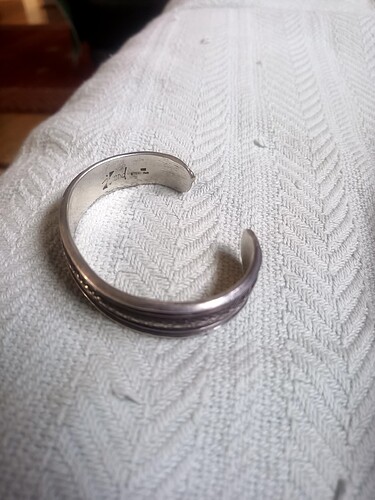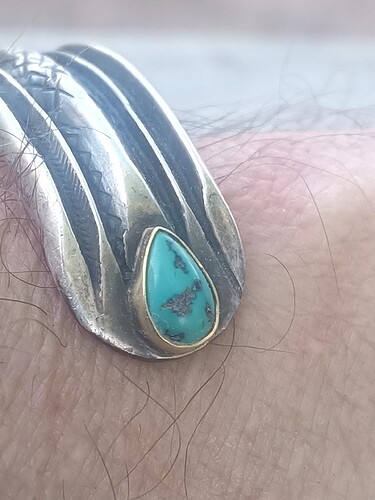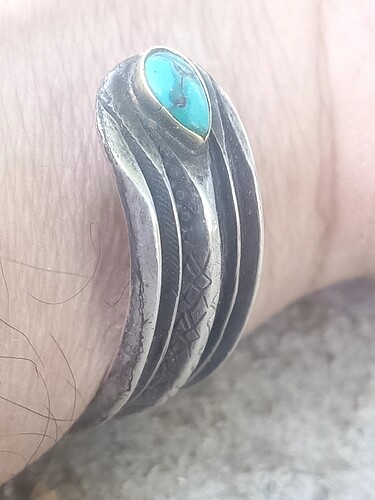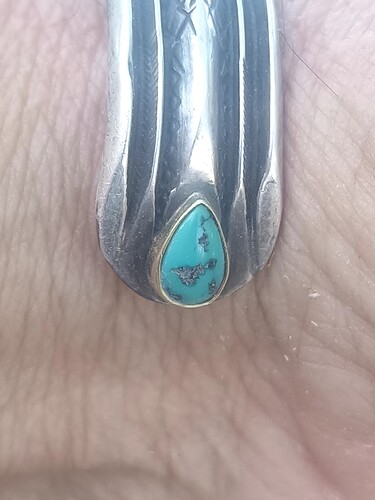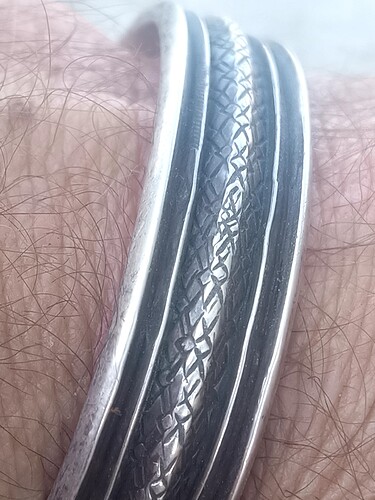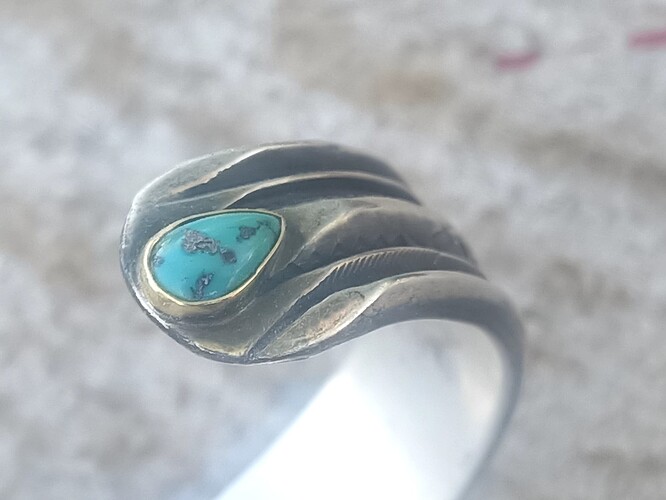Hello Brian, so very sorry that I did not see your reply until now. I need to keep up better. Yes, any info you have on Jay Bond would be very much appreciated. My Mom loves her pieces by him and has said she is taking them with her when she goes. Please share and thank you so much!
Here’s the auction and photos from 2015 at
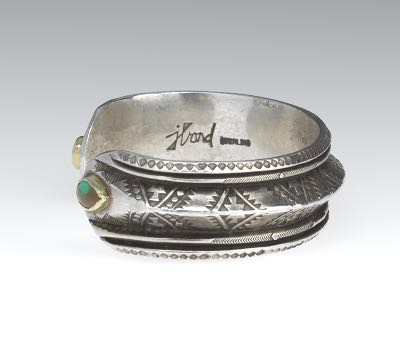
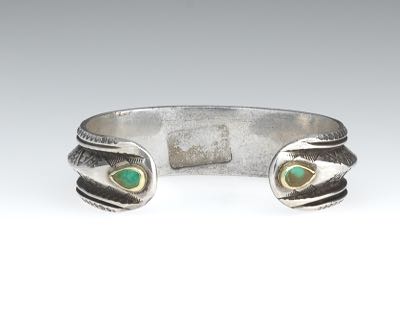
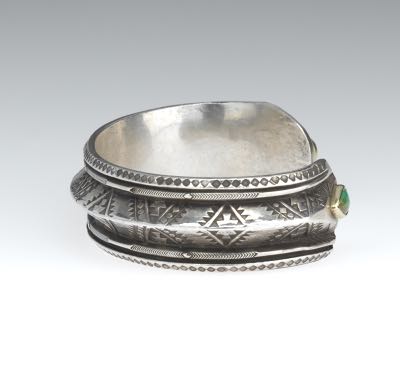
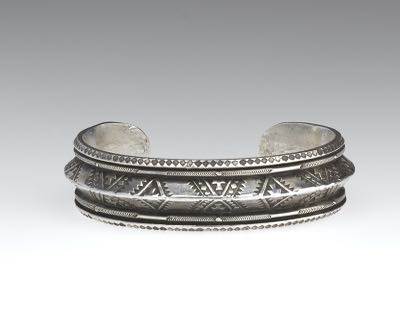
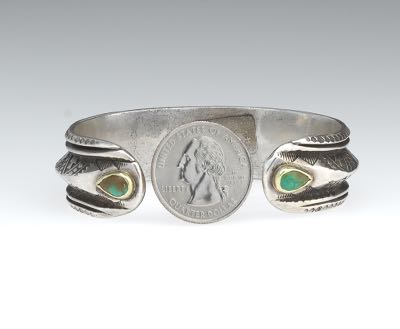
No, Jay Bond isn’t Native American. Not by any means. He’s definitely Anglo. In the 80s and 90s I’d see him at the Hippo Cafe on Harvard, the Frontier Restaurant, and Yale Park at UNM in Albuquerque.
His bracelets, or swedge cuffs, were sold by an auction house Aspireauction.com or something like that in 2015 I believe.
I have only two. This fits me and another is way too small.
Thank you a million times over! Mom will be so happy to have this info on him. There is very little out there. Your cuffs are wonderful!
why is it always left for me?
“Bond…Jay Bond”
lol
The stamps are amazing, as is the level of skill that went into making them
With regard to construction, the more complex bracelets are hand fabricated from sections of milled sheet and wire, with really excellent stamp work. the ‘carinated’ triangular sections of the bracelet are heavy gauge triangle wire, placed in a triangular slot in a specialized steel anvil, and hand stamped prior to shaping and/or assembly.
To me while these lovely pieces have a Native - ish feel to them, and definitely work for the Southwest I also see strong design influences from North Africa and the Middle East in Bond’s work.
Jay in 80s 90s Albuquerque was a flamboyant character who didn’t have any fixed abode and if he had access to machine tools he kept it secret. And the same for a secure storage location.
I believe he came to New Mexico from Ohio, which could explain the large number of auction items at Aspire Auctions in 2015 because one of their three locations is Cleveland, Ohio. He’d have needed some kind of middleman or a family connection to hook up with a big auction house.
@chicfarmer mmrogers mentioned carinating the triangular wire to attach it to the cuff using a specialized steel anvil. How is it bonded exactly? On my two cuffs there’s absolutely no sign that three pieces of silver were magically made into one without even the slightest sign of their melding together.
@MelindaC you wanted to find out who he is, it might not be absolutely truthful to do this, but Aspire Auctions did apparently list and sell a number of Jay’s swedge cuffs in 2015.
You have seven of them and so you could contact the auction house to enquire as to their likely value if offered for sale. And then incidentally you could try to find out more about the very mysterious Jay Bond, who often would imitate the James Bond character saying his name in the movie scenes with 007.
Of course it’d be somewhat deceptive to be trying to get info on false pretenses but it’s an auction house so they probably get a lot of that all the time.
If you couldn’t do it, which requires a sort of acting performance, you might know someone who could try to get that info from them on your behalf. It’s certainly possible someone there knows a lot about Mr. Jay Bond and the details of how and where he made those swedge cuffs.
Interesting thread! I’ll definitely be on the lookout for some J Bond…those are all magnificent!
Becky
People use a swage block (I’ve seen blocks just for triangle wire too), to hold the wire while stamping. I think this cuff is made with 5 stamped wires - two smaller wires, the big triangle and another two small wires laid flat on a sterling sheet, soldered, formed* & stones set. You don’t see gaps or solder blobs between the wires because this cuff was made by a very skilled craftsman, easily half the work of any really fine piece of jewelry is the finishing.
*the cuff may have been formed using a press…idk, maybe just a big nylon hammer and a wood mandrel
My father was a mechanical engineer who designed the world’s first high-speed hydraulic hammer press delivering over a million foot-pounds. I never really paid any attention to what they did with those General Dynamics Dynapak machines he was chief engineer on the patents you could look up Milt Chanin.
I’m confused about hearing of solder. There’s hammering and also soldering? How does the soldering and hammering go together? I see the five triangular wires all in parallel as a consistent design. Could you point us to a website that describes the procedure of carinating?
And how unusual is his arrangement of the five triangular components?
I have some .999 Silver Eagles. If I stack two on hard concrete and keep hitting them with a hammer they’re not gonna bond, not even on a 100 F summer day all day long.
To expand on @Khmetal work’s excellent analysis and description, @dchanin, In this case the term ‘carinated’ is technically inaccurate, as the wire upon which Jay has used embossing stamps is solid factory milled sterling triangle wire purchased from a supply house, rather than a triangular construction of several pieces of silver sheet soldered together to form a triangular structure. The anvil, or swedge block Khmetalwork mentioned is a specialized solid rectangular steel block with recessed triangular cuts machined or cast into the surface into which the triangle wire is placed to provide a solid stable surface to stamp one or more of the the three flat surfaces present on the wire.
The stamps look handmade, and while it would not require any specialized equipment to make them, they are expertly and meticulously crafted.
Auction on Ebay of one swedge cuffs that’s just one large triangular cross section sold for $174.95 March 25, 2023, a month ago! Seller was upstatepreciousmetals in Greenville, SC with many similar items. @MelindaC You could contact them to find out if they have more or know anything about Jay’s whereabouts.
Sellers description:
Jay Bond .925 Sterling Silver Native American Swedge Cuff Bracelet 5.5". This bracelet weighs 34.8 grams. It fits up to a 5.5" wrist as is. Gap distance is 0.83". The bracelet measures 0.34" wide. Nice intricate design. Don’t miss your chance.
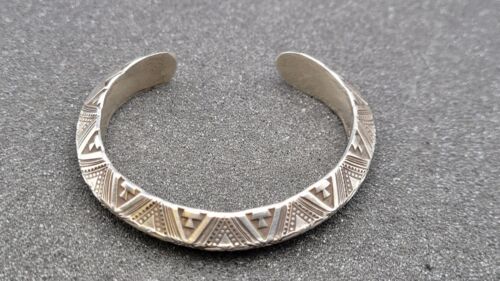
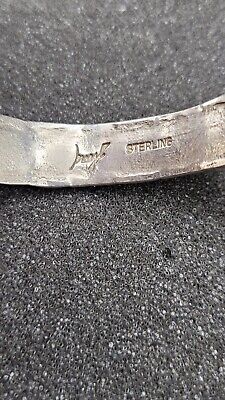
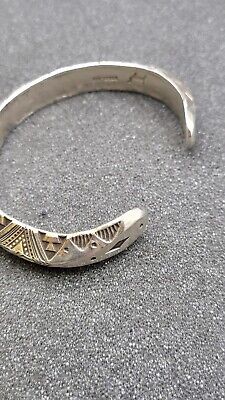
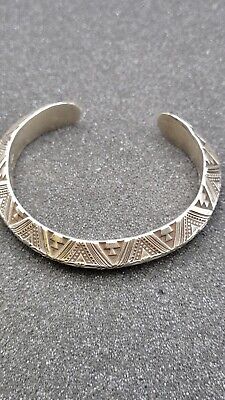
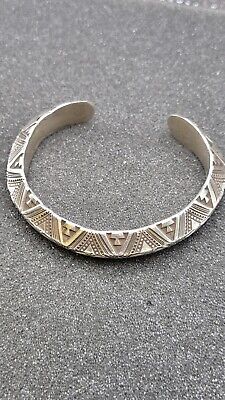

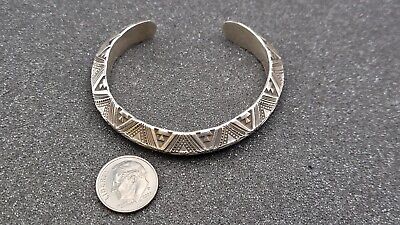
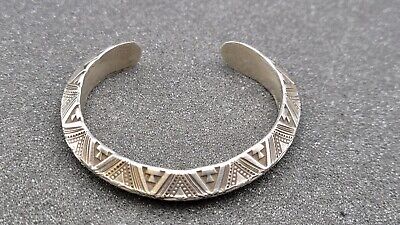
I’m sorry but how are the five triangular components seamlessly bonded and melded into one?
My father’s Dynapak could do it with up to a million foot-pounds in a hydraulic hammer press. But a human using hand tools, how?
My cuff that I wear almost daily that I’ll try to photograph has the largest triangle in the center, the next largest triangles on the outer edges of the cuff, and two very thin almost blades they’re so thin, those are between the central triangle and the two outside triangles.
Those components are so thin they look very fragile, especially so for sterling silver. Those intermediate thin blades show some slight bends and a nick or two from incidental contacts from me wearing it over the years.
He gave it to me when it was new and pristine with “zero miles.” And it was a gift though I forget the circumstances. He didn’t have a car and I knew him well enough to take him with me on the hour drive to the hot springs at Jemez Springs and then spend almost the entire day together.
It’s as if he designed it with the blades as a sort of odometer to record the mileage of wear it’s received as opposed to sitting in a drawer. Any hammering onto the assembled cuff would have to be done with those intermediate “odometer blades” protected somehow.
There are actually six pieces. Three lengths of triangle wire. Two lengths of heavy gauge sheet (12 or 14 gauge), and a heavy gauge backplate to which all of these pieces are silver soldered to join them all into the same piece. The lengths of wire are pre stamped, and laid out flat on the back plate. The entire assembly is soldered on to the back plate, and the rounded bracelet shape is then formed from the flat assembly over a steel mandrel using a heavy rawhide mallet. It’s a lot of work but is all done by hand or perhaps with a little bit of help from a hand operated hydraulic jack press.
@mmrogers Thank You kindly. Hydraulic press, hmmm.
Haha…. I think we’re comparing apples to oranges here. The type of press Khmetalwork and I are referring to is a small hand operated press of the type used in jewelers workshops for forming, and bending work. My shop doesn’t use them for this type of work, but some shops do. I suspect your bracelet was formed by hand on a steel mandrel with a rawhide or other heavy, non marking mallet.
The bracelet I have from Jay could be an exact twin of the bracelet that was photographed against a white background by Aspire Auctions for their auctions they listed in 2015, linked earlier in this thread but I downloaded them and will upload them in a reply below.
The thin ribbons between the center and the outer perimeter are so thin it seems to be a design feature that wearing it routinely with unavoidable contacts with countertops and tables with bumps and scratches would be like an odometer of wear, so he could tell if a person had worn it as opposed to keeping it in a drawer or a box not seen and enjoyed.
Unlike all the many other artists I’ve known who almost universally talk non-stop about the sacrifices and hardships of being an artist and living the artist’s life, Jay never said a word about where he made them or what it required. He just had them. He never talked about how he made them.
That is awesome to read, thanks. Recently i’ve been intrigued by Jay Bond and his work. I have a bracelet that very much resembles yours, but with (i guess) Carnelian stones instead of Turquoise. Really love his work and it’s sturdiness, while at the same time having refined decorations.





From Aspire Auctions in 2015
